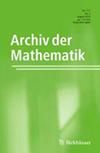发散形式算子最大正则性的反例
IF 0.5
4区 数学
Q3 MATHEMATICS
引用次数: 0
摘要
在本文中,我们提出了抛物线 PDE 最大 \(L^p\)-regularity 的反例。例子是一个具有空间和时间相关系数的发散形式的二阶算子。众所周知,Lions 理论认为在系数的协迫性条件下,此类算子在 \(H^{-1}\)上具有最大 \(L^2\)-正则性,而不需要任何时间和空间上的正则性条件。我们证明,一般来说,我们不能期望在\(H^{-1}(\mathbb {R}^d)\)上具有最大的\(L^p\)-正则性,也不能期望在\(L^2(\mathbb {R}^d)\)上具有\(L^2\)-正则性。本文章由计算机程序翻译,如有差异,请以英文原文为准。
Counterexamples to maximal regularity for operators in divergence form
In this paper, we present counterexamples to maximal \(L^p\)-regularity for a parabolic PDE. The example is a second-order operator in divergence form with space and time-dependent coefficients. It is well-known from Lions’ theory that such operators admit maximal \(L^2\)-regularity on \(H^{-1}\) under a coercivity condition on the coefficients, and without any regularity conditions in time and space. We show that in general one cannot expect maximal \(L^p\)-regularity on \(H^{-1}(\mathbb {R}^d)\) or \(L^2\)-regularity on \(L^2(\mathbb {R}^d)\).
求助全文
通过发布文献求助,成功后即可免费获取论文全文。
去求助
来源期刊

Archiv der Mathematik
数学-数学
CiteScore
1.10
自引率
0.00%
发文量
117
审稿时长
4-8 weeks
期刊介绍:
Archiv der Mathematik (AdM) publishes short high quality research papers in every area of mathematics which are not overly technical in nature and addressed to a broad readership.
 求助内容:
求助内容: 应助结果提醒方式:
应助结果提醒方式:


